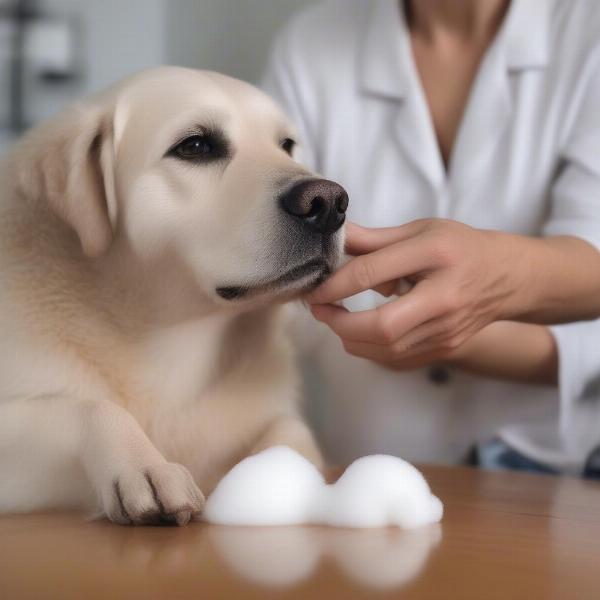OptiCare for dogs refers to the comprehensive care and maintenance of your dog’s eye health. Just like humans, dogs can experience a range of eye issues, from minor irritations to serious conditions. Understanding the common eye problems in dogs, preventive measures, and when to seek veterinary attention is crucial for every responsible dog owner. This guide will equip you with the knowledge you need to ensure your furry friend’s eyes stay healthy and bright.
Understanding Common Canine Eye Problems
Several eye problems can affect dogs, varying in severity and symptoms. Some of the most common include:
- Conjunctivitis: Often referred to as “pink eye,” conjunctivitis is an inflammation of the conjunctiva, the membrane lining the eyelid and covering the white part of the eye. It can be caused by allergies, infections, or irritants.
- Cataracts: These are cloudy areas that develop within the lens of the eye, obstructing vision. Cataracts can be age-related, genetic, or caused by underlying health issues like diabetes.
- Glaucoma: This condition is characterized by increased pressure within the eye, which can damage the optic nerve and lead to blindness if left untreated.
- Cherry Eye: This occurs when the gland in the third eyelid prolapses, appearing as a red, fleshy mass in the corner of the eye.
- Dry Eye (Keratoconjunctivitis Sicca – KCS): This condition arises when the tear glands fail to produce enough tears, leading to dry, irritated eyes.
Preventive Measures for Optimal Eye Care
Maintaining good eye hygiene and taking preventive measures can significantly reduce the risk of eye problems in dogs. Here are some key steps:
- Regular Eye Checks: Inspect your dog’s eyes regularly for any signs of redness, discharge, swelling, or squinting.
- Gentle Cleaning: If you notice any discharge, carefully clean the area around the eyes with a soft, damp cloth. Avoid using harsh chemicals or soaps.
- Grooming: Keep the hair around your dog’s eyes trimmed to prevent it from irritating the eyes.
- Protection from Irritants: Shield your dog’s eyes from dust, wind, and other potential irritants, especially during car rides or outdoor activities.
- Balanced Diet: A nutritious diet rich in antioxidants and omega-3 fatty acids can contribute to overall eye health.
 Cleaning a dog's eyes
Cleaning a dog's eyes
When to Seek Veterinary Care
While some minor eye irritations may resolve on their own, it’s essential to seek veterinary attention if you notice any of the following:
- Persistent redness or discharge
- Swelling or pain around the eyes
- Squinting or excessive blinking
- Cloudiness in the eye
- Changes in vision or behavior
Early diagnosis and treatment are crucial for preventing serious complications and preserving your dog’s vision.
OptiCare and Breed-Specific Concerns
Certain breeds are predisposed to specific eye conditions. For example, brachycephalic breeds like Pugs and Bulldogs are more prone to eye injuries due to their protruding eyes. Understanding the potential eye problems associated with your dog’s breed can help you take proactive steps to protect their eye health.
Conclusion
OptiCare for dogs is an essential part of responsible pet ownership. By understanding common eye problems, practicing preventive measures, and seeking timely veterinary care, you can help ensure your dog enjoys a lifetime of healthy vision. Don’t hesitate to contact your veterinarian if you have any concerns about your dog’s eye health.
FAQ
- How often should I clean my dog’s eyes? Clean your dog’s eyes as needed, typically when you notice discharge. For dogs prone to eye issues, daily cleaning might be necessary.
- Can I use human eye drops on my dog? Never use human eye drops on your dog without consulting your veterinarian. Human medications can be harmful to dogs.
- What are the signs of glaucoma in dogs? Signs include redness, cloudiness, dilated pupils, and squinting.
- Is cherry eye painful for dogs? While not always painful, cherry eye can cause irritation and discomfort.
- How can I protect my dog’s eyes from the sun? Consider using dog-specific goggles to shield your dog’s eyes from harmful UV rays.
- What is the best way to trim the hair around my dog’s eyes? Use blunt-ended scissors and exercise extreme caution to avoid injuring the eye.
- Can a dog’s diet affect its eye health? Yes, a balanced diet rich in antioxidants and omega-3 fatty acids can promote eye health.
ILM Dog is your trusted resource for all things dog-related. We provide expert advice on dog breeds, health, training, nutrition, grooming, and much more. For personalized guidance on your dog’s OptiCare needs or any other canine-related concerns, contact our team of experts at [email protected] or call us at +44 20-3965-8624. Visit ILM Dog for more valuable information and resources to help you provide the best care for your furry friend.